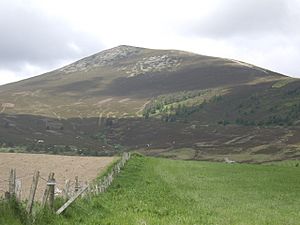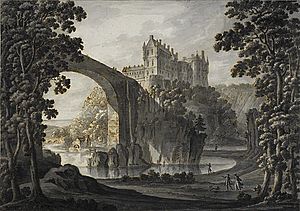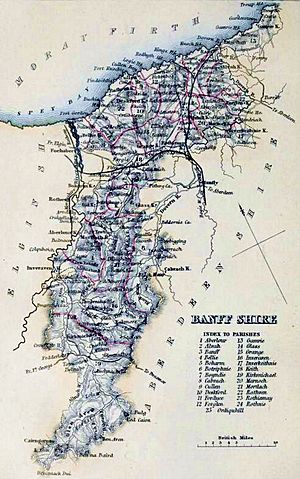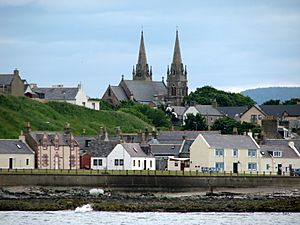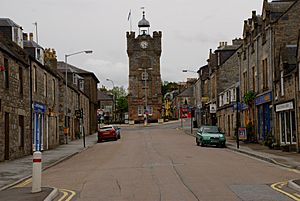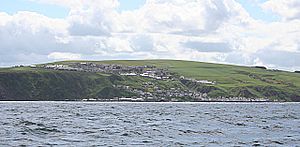Banffshire facts for kids
Quick facts for kids
Banffshire
|
|
|---|---|
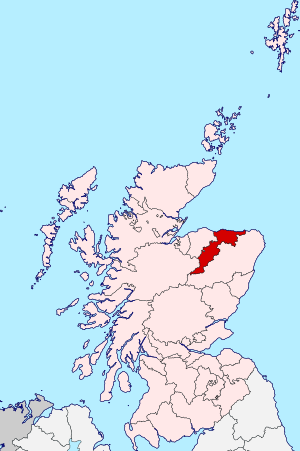 |
|
| Country | Scotland |
| County town | Banff |
| Area | |
| • Total | 641 sq mi (1,660 km2) |
| Ranked 13th of 34 | |
| Chapman code |
BAN
|
| Website | https://www.lordlieutenantbanffshire.co.uk/ |
Banffshire (pronounced BANF-sher) is a special part of Scotland. It's known as a historic county, which means it's an old area with its own history and traditions. It's also a registration county and a lieutenancy area. The main town, or county town, is Banff. However, the biggest town in Banffshire is Buckie, which is located to the west.
Banffshire is on the coast, touching the Moray Firth in the north. It shares borders with Morayshire and Inverness-shire to the west. To the east and south, it borders Aberdeenshire.
Contents
Local Government Changes
From 1890 to 1975, Banffshire had its own local government called the Banffshire County Council. This council helped manage the area and was based at the Sheriff Court and County Hall in Banff.
In 1975, things changed for local government in Scotland. Banffshire County Council was stopped. The land was then split between two new areas: Moray and Banff and Buchan. These new areas were part of a larger region called Grampian.
Later, in 1996, the Grampian region was also changed. Now, the land that was once Banffshire is part of the council areas of Moray and Aberdeenshire. It's important to know that the borders of these new areas are a bit different from the old historic counties.
Geography of Banffshire
Banffshire has a long and thin shape. It stretches for about 30 miles along the coast of the Moray Firth. This coastal part goes from Spey Bay to Cullaykhan Bay.
From the coast, the county reaches inland for about 55 miles. This gives Banffshire its unique, stretched-out look.
A Look Back in History
People have lived in Banffshire for a very long time, even before recorded history! There's lots of proof of early human life, especially near the coast. For example, ancient stone mounds called cairns, like the Longman Hill cairn and Cairn Lee, can be found in the northern part of Banffshire.
The area also has the remains of several old castles from the Middle Ages. You can also find the 12th-century church, or kirk, of Gamrie.
Civil Parishes
Civil parishes are old divisions of land that are still used today for some things, like collecting statistics. They haven't changed much since the 1800s, which helps people compare population numbers over many years.
From 1845 to 1930, these parishes were part of how local areas were managed in Scotland.
Towns and Villages
Here are some of the towns and villages you can find in Banffshire:
- Aberchirder
- Banff
- Buckie
- Charlestown of Aberlour
- Cullen
- Dufftown
- Findochty
- Fordyce
- Gardenstown
- Glenlivet
- Keith
- Macduff
- Portgordon
- Portknockie
- Portsoy
- Tomintoul
- Whitehills
Transport Links
The main railway line that connects Aberdeen and Inverness runs through the town of Keith, which is in the northern part of Banffshire.
Castles of Banffshire
Banffshire is home to several historic castles, some of which are now ruins. These castles tell stories of the past. Here are some of them:
- Auchindoun Castle
- Balvenie Castle
- Banff Castle
- Cullen Castle
- Deskford Castle
- Fordyce Castle
- Inchdrewer Castle
Famous People from Banffshire
Many interesting people have come from Banffshire:
- James Abercromby (1706–1781): Born in Glassaugh, he became a British general who fought in the French and Indian War.
- Captain George Duff RN (1764–1805): Born in Banff, he was a brave officer in the Royal Navy. He sadly died in the famous Battle of Trafalgar.
- James Ferguson (1710–1776): Born in Rothiemay, he was a skilled astronomer and made scientific instruments. He was even a member of the Royal Society!
- Saint John Ogilvie (1579–1615): Born in Keith, he was a Scottish Catholic martyr, meaning he died for his religious beliefs.
- George Stephen, 1st Baron Mount Stephen (1829–1921): He was a very important Canadian railway executive. He named Banff, Alberta, in Canada, after his birthplace in Banffshire. This is why Banff National Park and the Banff Springs Hotel in Canada are linked to Banffshire.
Common Surnames
When a census was taken in 1881, these were the most common family names in Banffshire:
- Smith
- Grant
- Wilson
- Reid
- Watt
- Stuart
- Morrison
- Murray
- Cowie
- McDonald
See also
- Lord Lieutenant of Banffshire
- Banffshire (UK Parliament constituency)
- List of counties of Scotland 1890–1975



